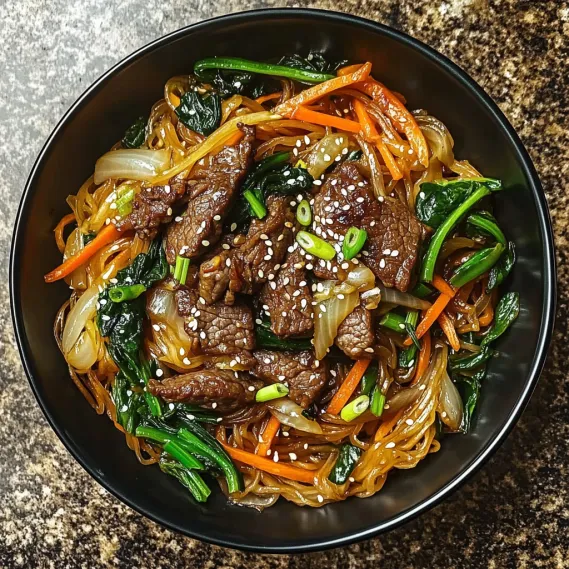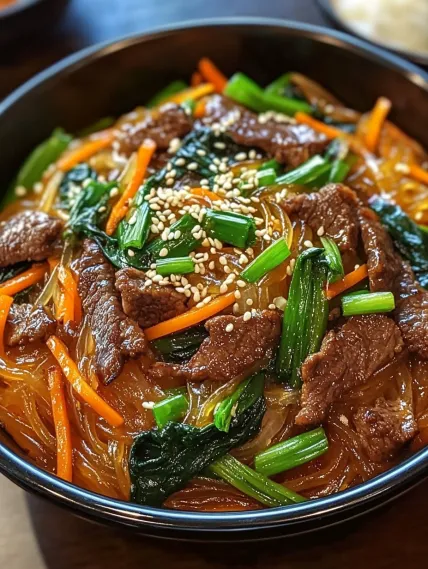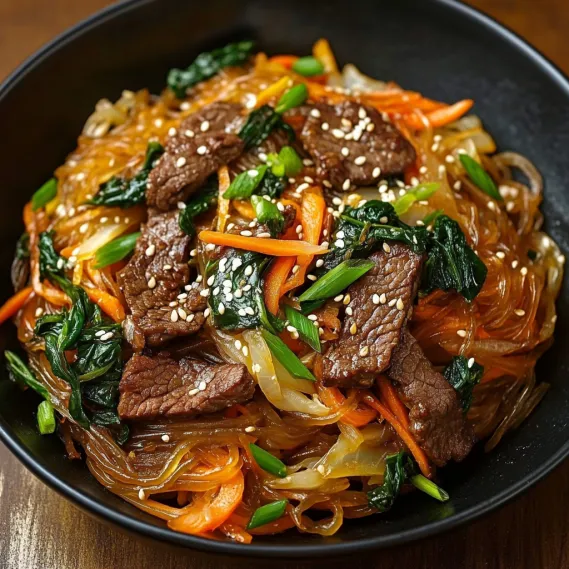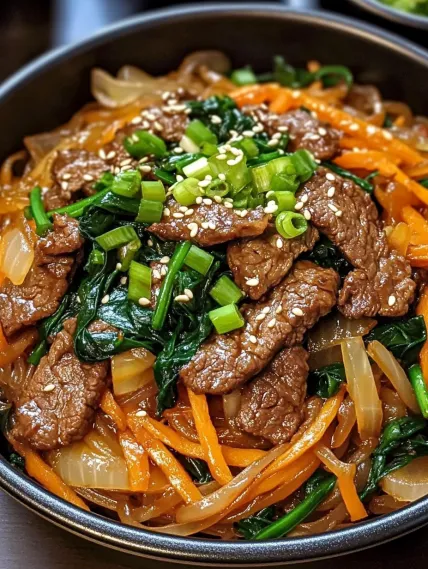 Pin it
Pin it
Sweet potato glass noodles meet juicy beef strips and colorful veggies in this mouthwatering Korean classic. The stretchy noodles create an amazing contrast with the crisp-yet-tender vegetables and flavorful meat, all wrapped in a shiny coating of nutty sesame oil and rich soy sauce. Bright orange carrots, fresh spinach, and sliced onions don't just make this dish pop visually—they add depth of flavor and plenty of nutrients. It's a taste of genuine Korean cooking that'll satisfy both your hunger and your sense of adventure.
After coming back from Seoul completely obsessed with this noodle dish, my first try making it at home was a total flop—mushy noodles and veggies cooked to death. It took several attempts and some coaching from my Korean buddy before I got the hang of cooking each part separately then mixing them together. Now when friends come over, this is my showstopper—they can't believe how complex it tastes with such basic ingredients.
Key Components and Shopping Advice
- Sweet Potato Glass Noodles: These see-through noodles are what makes the dish special. You'll find them at Asian markets or online. Don't swap in rice or wheat noodles—they won't give you that bouncy texture you want.
- Beef: Go for thin-cut ribeye or sirloin. Pop it in the freezer for 20 minutes before cutting to get those super-thin slices that cook fast and stay tender.
- Vegetables: Mix it up with carrots, spinach, and onions. Cut everything about the same size so they cook evenly and look pretty together.
- Sesame Oil: This fragrant oil gives japchae its distinct nutty flavor. Get the real stuff, not a blend.
- Soy Sauce: Forms the base of your sauce. Try low-sodium if you're watching your salt.
Trust me, splurging on good sesame oil really pays off in this dish. The deep, toasty flavor from quality oil makes everything taste more authentic—it's usually what gets people coming back for another helping.
Step-by-Step Cooking Guide
- Step 1: Get the Noodles Ready
- Boil a big pot of water and drop in your sweet potato noodles for 5-6 minutes until they're soft but still got some bite to them. Don't let them turn to mush—they should still push back a little when you chew. Drain and run cold water over them to stop them cooking.
- Step 2: Fix Up and Cook the Beef
- Mix your thin beef slices with soy sauce, sesame oil, and brown sugar. Let it sit for 10 minutes while you work on other stuff. Get a big skillet or wok really hot and cook the beef until it browns. Take it out and set it aside.
- Step 3: Handle the Veggies
- Using the same pan, add some olive oil. Cook each veggie one after another: carrots first until they soften a bit, then onions until see-through, then garlic, and finally spinach just long enough to wilt. Move each one to a plate as you finish it.
- Step 4: Mix Up the Sauce
- In a small bowl, stir together the leftover soy sauce, sesame oil, and brown sugar until the sugar melts. This balanced sauce will coat everything with that amazing sweet-savory taste that makes japchae so good.
- Step 5: Put It All Together
- Put the noodles back in the pan over medium heat. Pour on the sauce and toss until the noodles are coated. Add your cooked beef, veggies, and green onions, gently turning everything together until it's all hot.
- Step 6: Final Touch
- Give it a taste and add salt if needed. Everything should taste just right, with tender noodles and flavorful beef.
 Pin it
Pin it
When I made this for my daughter's graduation party, I was so touched when Korean guests came up to tell me it tasted just like their moms' versions. My trick was cooking each veggie on its own to keep the colors bright and textures right, then letting everything rest for an hour before serving so all the flavors could really sink in.
 Pin it
Pin it
Endless Ways to Enjoy Japchae
Japchae isn't just stuck in one lane—you can tweak it from simple side to full-on main dish. I've found mushrooms are an awesome addition, especially shiitakes with their meaty bite and earthy taste that goes perfectly with the sweet-savory sauce. In summer, I throw in some sliced bell peppers for extra crunch and pop of color. For family get-togethers with different diets, I make a big batch of noodles and veggies, then let everyone pick their protein—beef for some, chicken, shrimp, or tofu for others. This build-it-yourself setup has turned into a monthly thing at our house, with everybody making their own perfect bowl.
Getting Those Noodles Just Right
It took me a few tries to figure out sweet potato noodles. They're not like regular pasta—they keep soaking up liquid after cooking, which can turn them into a soggy mess if you're not careful. My big aha moment was cooking them just until they had a bit of resistance, then cooling them right away under cold water. A light coating of sesame oil stops them sticking and adds flavor from the start. Now when I add the sauce, I just warm everything instead of simmering it, which keeps the noodles bouncy instead of mushy. My husband used to be all about rice dishes but now asks for japchae all the time, specifically mentioning how much he loves the 'chewy noodle texture.'
Creating Harmony in Taste and Appearance
Korean cooking focuses on balance in flavor, color, and nutrition—something called 'banchan.' I use this idea when making japchae, making sure each veggie brings both taste and visual appeal. The dark green spinach, bright orange carrots, and purple-white onions don't just look pretty—they signal all the different nutrients in your bowl. I've noticed my veggie-hating son actually eats everything in his japchae without picking stuff out—the flavors work so well together that nothing feels out of place. When I teach cooking classes at our community center, japchae is my favorite example of how thoughtful prep makes food both beautiful and delicious.
Food as a Bridge to Culture
Making japchae has gone beyond just cooking a tasty meal—it's opened up Korean culture for our whole family. After learning it started as royal court food during the Joseon Dynasty, we got curious about other Korean traditions. Now we celebrate Korean holidays like Chuseok (their harvest festival) with japchae as the main attraction. My kids have learned about why the colorful presentation matters—it stands for harmony and good luck. What began as trying a new recipe has grown into real cultural appreciation, with Korean cookbooks filling our shelves and Korean dramas becoming our Friday night TV pick.
Cook's Best Advice
- Get everything cut, measured and ready before you start cooking—this dish moves fast once you begin
- Sprinkle toasted sesame seeds on top just before serving for extra crunch and nutty flavor
- When feeding a crowd, prep all components ahead and toss together just before everyone eats
- For some heat, mix a tablespoon of gochujang (Korean chili paste) into your sauce
- If serving as the main attraction, up the meat to 2.5-3 pounds for 10 people
When I first made this dish, I didn't let it rest after combining everything and it turned out kinda dry. Those few extra minutes of sitting really make all the difference in how creamy and integrated the final dish feels.
Smart Spending for Delicious Meals
This dish shows how smart cooking can stretch your budget while still feeling fancy. I grab extra cube steak whenever it's marked down and freeze it specifically for this recipe. The other ingredients last forever in your pantry, making this perfect for whipping up restaurant-quality food without spending takeout prices.
Making It Work for Everyone
Homes with different tastes will love how easy this dish is to customize. Kids who normally push veggies around their plate often enjoy this because the pasta soaks up all that mushroom goodness. A sprinkle of cheese can win over picky eaters, or throw in extra veggies like peas or corn to boost nutrition. Think of the base recipe as your starting point—from there, you can make changes to please everyone at your table.
Changing with the Seasons
This flexible main dish welcomes whatever produce is in season. Summer brings fresh corn or zucchini opportunities. Fall calls for roasted butternut squash or extra mushrooms. Winter versions work great with hearty root veggies. Spring welcomes tender asparagus tips and fresh peas. These tweaks keep meals interesting year-round while using what's fresh and cheap at your local market.
Time-Saving Prep Strategies
Busy families will love this recipe's make-ahead potential. You can prep the pasta and sauce up to three days early and keep them in the fridge. For longer storage, the fully finished dish freezes well for up to three months. Just thaw overnight in the fridge before baking as directed, adding a minute or two to the cooking time.
Pro Kitchen Tricks
- For deeper flavor, add a teaspoon of dried thyme or rosemary to your mushroom mix
- Lightly toast the potato chips before using for extra crunch
- Spice things up with a pinch of cayenne in the mushroom mixture
- For a thicker sauce, mix 1 tablespoon cornstarch with 2 tablespoons cold water and stir it in during the last 5 minutes
- This tastes even better as leftovers the next day
I found these little tricks after making this dish many times—especially adding rosemary, which brings amazing depth without anyone being able to point out exactly what that extra flavor is.
 Pin it
Pin it
This adaptable tuna noodle dish has become my go-to when I need something everyone enjoys. The mix of soft pasta, creamy sauce, and crunchy potato chips creates something magical—comfort food that feels special but comes together so easily.
This tuna noodle dish shows that amazing, satisfying food doesn't need fancy techniques or weird ingredients—just thoughtful handling of good basics that work perfectly together.
Frequently Asked Questions
- → What exactly are Korean sweet potato noodles, and where can I get them?
- Sweet potato noodles, also called dangmyeon, are made from starch and have a stretchy, almost chewy bite. Hunt for them in Asian markets, Korean shops, or online under 'glass noodles' or 'sweet potato noodles'.
- → Is there a meatless option for Japchae?
- Definitely! Skip the beef and pile on veggies like mushrooms (shiitake is awesome), zucchini, or bell peppers. You can toss in tofu as well. The soy-sesame sauce pairs great with just plants.
- → What's the best way to store leftover Japchae?
- Pack cooled Japchae into airtight containers and pop them into the fridge for up to 3-4 days. Since the noodles soak up sauce, stir in some sesame oil and soy sauce before reheating to wake up the flavors.
- → How do I stop my sweet potato noodles from clumping?
- Clumping happens often if noodles overcook or sit too long after boiling. Cool them under cold water right away after cooking, then toss with a splash of sesame oil to avoid sticking. Don’t stir-fry till it’s the end.
- → Can I prep Japchae beforehand for events?
- Yup! Japchae's tasty even at room temp and is ideal to make ahead. Keep it in the fridge covered, then serve it after it's warmed to room temp. A dab of fresh sesame oil can bring it back to life.
